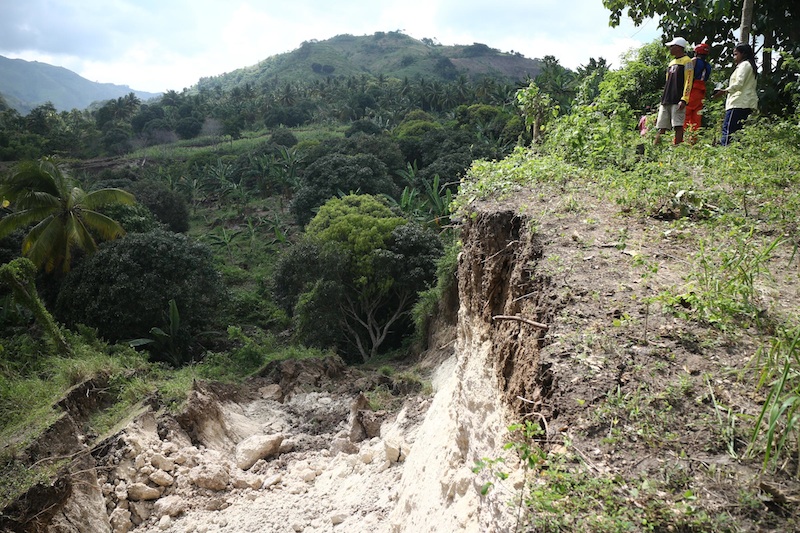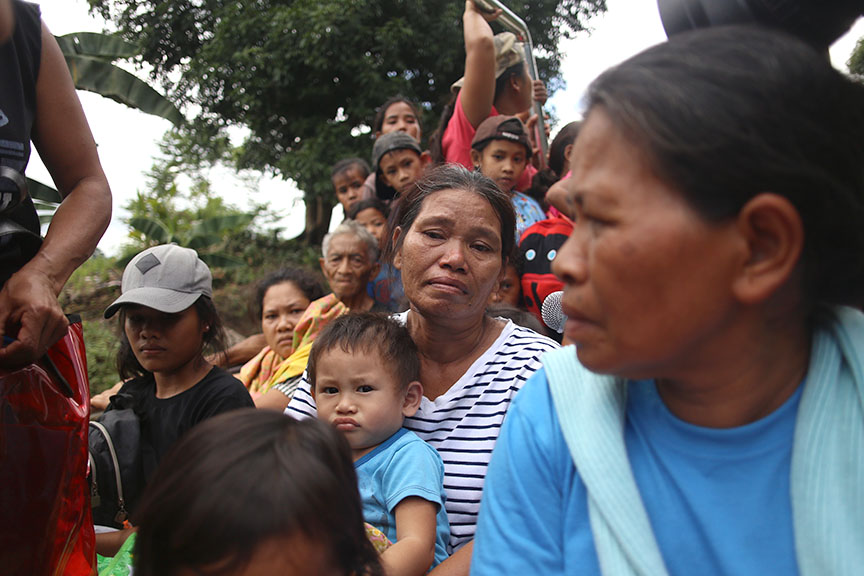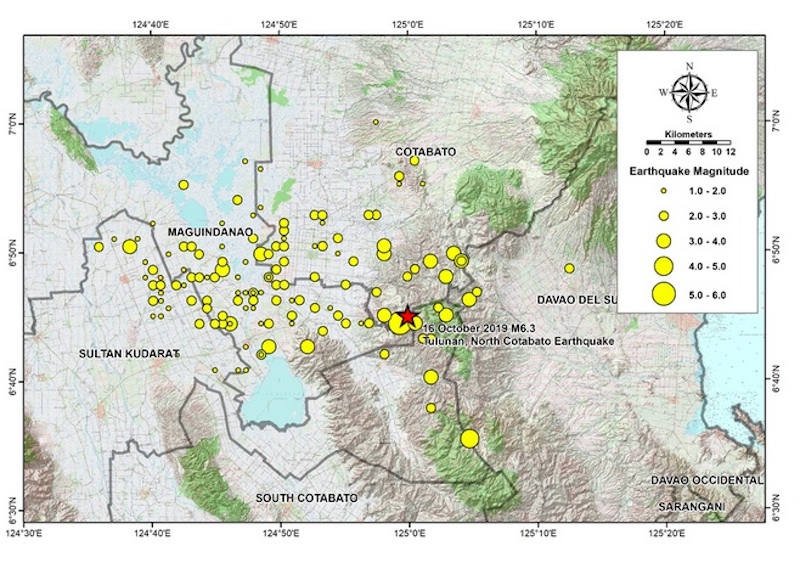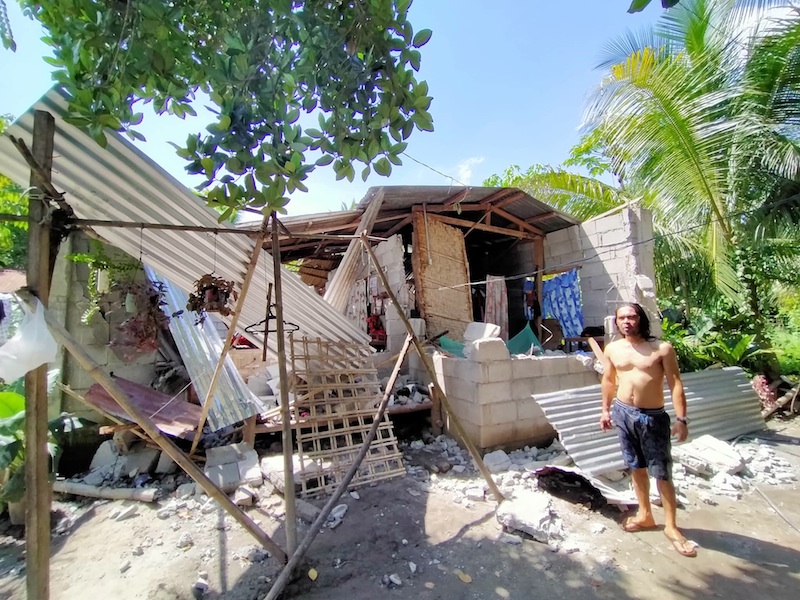DAVAO CITY (MindaNews / 19 October) – The Philippine Institute of Volcanology and Seismology (Phivolcs) urged residents in the areas hit by the Magnitude 6.3 earthquake on October 16 to “be cautious of structures visibly weakened or with signs of damage” as the aftershocks, expected to last for days or weeks, may further damage them.
“In case of houses and other buildings with visible damage, it is best to contact the Municipal/City Engineering Office for advice,” the Phivolcs said in its primer on the October16 quake, adding that affected buildings “should not be reoccupied unless certified by the engineers.”
It said engineers from the local government, other agencies and organizations should inspect buildings and infrastructure to determine their integrity, and recommend appropriate actions to the affected groups or individuals.

Restidents stand on the edge of the collapsed portion of a mountain in Barangay Malawanit in Magsaysay, Davao del Sur where two persons were killed during the magnitude 6.3 earthquake that struck the area on October 16, 2019. MindaNews photo takeo 17 October 2019
Phivolcs also said slopes should be “checked for tension/incipient cracks that may have resulted from the strong ground shaking” as it warned that tension cracks “may render slopes more susceptible to landslides.”
Phivolcs reiterated that preparedness is still “the best course of action.”
In case of another strong earthquake, Phivolcs reminded the public to protect themselves by doing the ‘drop, cover and hold’ routine and that in homes and offices, heavy furniture “should be strapped to the walls, and appliances be secured to prevent them from toppling and causing injuries to persons.”
Classes were suspended in the cities of Davao, Kidapawan and Cotabato and neighboring areas on Thursday and Friday as the city or municipal engineers checked on the structural integrity of schoolbuildings.
In its primer, Phivolcs also said that the quake, which struck at 7:37 p.m. and whose epicenter was 22 kilometers southeast of Tulunan in North Cotabato, was generated by the movement of a northwest-trending strike-slip fault in the area. “
It said Region 12 which includes North Cotabato, is one of the seismically active areas in the country because of the presence of the western extension of the Mindanao Fault (Cotabato-Sindangan Fault). Sindangan is in Zamboanga del Norte.
It added that the active fault traverses Sarangani province to northwest of Zamboanga Peninsula. It also noted that Cotabato Trench is also a major source of earthquakes which can affect the region.
 Residents of Barangay Malawanit in Magsaysay, Davao del Sur leave their homes for fear of aftershocks after the magnitude 6.3 earthquake hit Mindanao Wednesday evening (16 October 2019). MindaNews photo by MANMAN DEJETO
Residents of Barangay Malawanit in Magsaysay, Davao del Sur leave their homes for fear of aftershocks after the magnitude 6.3 earthquake hit Mindanao Wednesday evening (16 October 2019). MindaNews photo by MANMAN DEJETO
The Oct. 16 earthquake did not trigger a tsunami or a volcanic activity, the primer said.
It explained that even as the nearest active volcanoes from the epicenter are Matutum Volcano (~44 km) and Parker Volcano (~78 km), the quake and its aftershocks are tectonic in origin.
But Phivolcs said it would still monitor. “As part of DOST-PHIVOLCS monitoring procedures for moderate to large earthquakes occurring near active volcanoes, the Institute will closely monitor earthquake events in relation to any activity that may be associated with Matutum and Parker Volcanoes,” it said.
It did not also trigger a tsunami because the epicenter of the quake was inland and North Cotabato province is landlocked “hence it is safe from tsunami,” Phivolcs said.
The quake affected nearly half of Mindanao’s 27 provinces.
 Courtesy of Phivolcs.
Courtesy of Phivolcs.
According to Phivolcs, the quake registered Intensity 7 (destructive) in North Cotabato’s Tulunan, M’lang and Kidapawan City; and Intensity 6 (very strong) in Tacurong City and Sto. Nino in South Cotabato and Digos City in Davao del Sur.
It was Intensity 5 (strong) in North Cotabato’s Pikit and President Roxas towns; in South Cotabato’s Lake Sebu, Polomolok, Tampakan and Tupi towns and in the cities of General Santos and Koronadal; in Sultan Kudarat’s Kalamansig, Lebak and Palembang towns; in Sarangani’s Alabel and Malungon towns; and in Davao City.
 One of the houses destroyed by Wednesday night’s Magnitude 6.3 quake in Barangay La Esperanza, Tulunan, North Cotabato. Photo courtesy of ERWIN ANGULO
One of the houses destroyed by Wednesday night’s Magnitude 6.3 quake in Barangay La Esperanza, Tulunan, North Cotabato. Photo courtesy of ERWIN ANGULO
Intensity 4 (moderately strong) was felt in Kiamba, Esperanza and Rosario towns in Agusan del Sur; in Bukidnon’s Kalilangan, Quezon, Kadilignan and Damulog towns; Mawab in Compostela Valley; in Maguindanao’s Barira, Matanog and Sultan Kudarat towns; and in Cotabato City.
It was Intensity 3 (weak) in the cities of Dipolog and Iligan; and Santa Josefa in Agusan del Sur; Intensity 2 (slightly felt) in the cities of Butuan and Zamboanga); and Intensity 1 (scarcely perceptible) in Hinatuan, Surigao del Sur. (Carolyn O. Arguillas / MindaNews)
